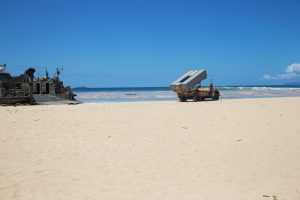The U.S. Navy’s largest exercise in a generation concludes this week, involving more than 20,000 sailors and Marines, more than two dozen warships, a dozen headquarters, and five fleets spread across the globe. The Large Scale Exercise 2021 is unique because it integrated operations across both its Atlantic- and Pacific-based fleets to respond either to a multi-front war or two separate regional crises. The navy plans to run future Large Scale Exercises every three years, incorporating increasing numbers of international partners.
This inaugural exercise was originally planned for last year, but was delayed by the COVID-19 pandemic.
Unspoken, but geographically implied, is that the navy is using the exercises to examine how it would respond to simultaneous regional conflicts with China and Russia. China and Russia have significantly strengthened their defense ties over the last few years, part of a multi-decade effort by both countries to get past their Cold War antagonism. They are not formal allies, but do increasingly coordinate where their interests align. U.S. defense planners worry that a conflict with one may lead to the other taking opportunistic advantage of the crisis.
This appears to be the view in China as well. An outside analysis published by the People’s Liberation Army (PLA) called LSE 2021 “more targeted” than other U.S. Navy exercises, saying it “involved warfare concepts that might be used in case of a conflict with the Chinese army and aimed to deliver signals of military deterrence to China and Russia.”
The U.S. Navy and Marine Corps have been refining those concepts for years now. They include so-called distributed maritime operations, operating from expeditionary marine bases on remote islands, and operating in contested littoral spaces. In sum, the concepts test how the navy envisions it would have to fight against China in East Asia, where operating environments transition from the deep “blue water” of the Western Pacific to the shallow, archipelagic regions in the first island chain and South China Sea. LSE 2021 is the first time the U.S. Navy and Marine Corps have tried to put all these pieces together into warfighting scenarios with actual units.
Both the east and west coast fleets tested “surging” their headquarters, an idea now several years old. The San Diego-based 3rd Fleet packed up and directed portions of the exercise from a small tent-city set up in Pearl Harbor, while the newly reestablished, Norfolk, Virginia-based 2nd Fleet did the same from a tent at a nearby amphibious base. This is the first time the 2nd Fleet has tested an expeditionary headquarters concept, something the 3rd Fleet began exploring in 2016 with mixed results.
One of the most interesting elements of the exercise was the U.S. Marine Corps’s concept of fighting for control of the sea from ashore. The marines began looking at adding mobile anti-ship cruise missiles to their arsenal several years ago with the idea that a constellation of batteries placed on remote islands in crowded strategic waters, such as those in the South China Sea or Japan’s Ryukyu chain, could help relieve demand on the navy to secure sea lanes or target adversary fleets. The marines test-fired the multi-mission naval strike missile – which has also been added to the navy’s under-armed littoral combat ships and tested by U.S. Army artillery units in an anti-ship role – late last year and integrated the missile with its expeditionary basing concept during the LSE last week.
After landing on a remote Kauai beach using navy landing craft and marine tilt-rotor aircraft, the marines established what they call an expeditionary advanced base and successfully hit a target ship with the missiles, a retired U.S. Navy frigate.
Individual live-fire drills and flexing interoperability with Japanese and British ships obscures the bigger picture of the exercise, which was to integrate all these actions at the fleet level instead of the smaller strike-group centric exercises that the U.S. Navy typically conducts.
Admiral Christopher Grady, head of the navy’s Fleet Forces Command, explained: “We have shifted focus from the individual Carrier Strike Group to a larger fleet-centric approach, challenging fleet commanders’ abilities to make decisions at a speed and accuracy that outpaces the adversaries… LSE is more than just training; it is leveraging the integrated fighting power of multiple naval forces to share sensors, weapons, and platforms across all domains in contested environments, globally.”
This builds on “Fleet Problems” introduced by Admiral Scott Swift when he was head of the U.S. Pacific Fleet. Swift recognized that any potential conflict with China would require coordinating multiple strike groups, marines, and air force capabilities, a scale of effort that the U.S. Navy had not seriously practiced fighting since the end of the Cold War.

































